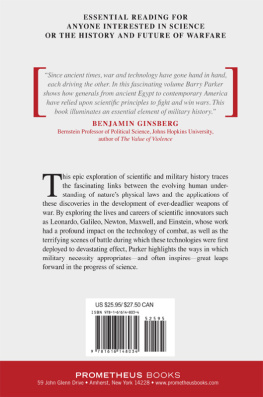
Aczel, Amir. Uranium Wars. New York: MacMillan, 2009.
Asimov, Isaac. The History of Physics. New York: Walker, 1966.
Baggott, Jim. The First War of Physics. New York: Pegasus, 2010.
Bronowski, J. The Ascent of Man. Boston: Little, Brown, 1973.
Brown, Louis. A Radar History of World War II. Philadelphia: Institute of Physics Publishing, 1999.
Buderi, Robert. The Invention That Changed the World. New York: Simon and Schuster, 1996.
Collier, Basil. The Battle of Britain. New York: MacMillan, 1962.
Griffith, Paddy. Battle Tactics of the Civil War. New Haven, CT: Yale University Press, 1987.
Guillen, Michael. Five Equations That Changed the World. New York: Hyperion, 1996.
Guilmartin, John. Gunpowder and Galleys. Cambridge: Cambridge University Press, 1964.
Hardy, Robert. Longbow: A Social and Military History. New York: Lyons and Burford, 1993.
Hodges, Andrew. Alan Turing: The Enigma. Princeton, NJ: Princeton University Press, 2012.
Hughes, B. P. Firepower: Weapon Effectiveness on the Battlefield, 16301850. New York: Da Capo, 1997.
Jones, R. V. Most Secret War. New York: Penguin, 2009.
Keegen, John. A History of Warfare. New York: Vintage, 1994.
Kelly, Jack. Gunpowder. New York: Basic Books, 2004.
Kennedy, Gregory. Germany's V-2 Rocket. Atglen, PA: Schiffer, 2006.
Maraden, E. W. Greek and Roman Artillery. New York: Oxford, 1969.
O'Connell, Robert. Of Arms and Men. New York: Oxford, 1989.
Padfield, Peter. Guns at Sea. New York: St. Martin's, 1974.
Pais, Abraham. J. Robert Oppenheimer: A Life. New York: Oxford University Press, 2006.
Parker, Barry. Science 101: Physics. Irvington, NY: Collins, 2007.
Partington, J. R. A History of Greek Fire and Gunpowder. Baltimore: Johns Hopkins University Press, 1999.
Rhodes, Richard. Dark Sun. New York: Simon and Schuster, 1995.
. The making of the Atomic Bomb. New York: Simon and Schuster, 1986.
Sarton, George, Ancient Science through the Golden Age of Greece. Mineola, NY: Dover Publications, 2011.
Sebag-Montefiore, Hugh. Enigma: The Battle of the Code. New York: Wiley, 2004.
Snodgrass, A. M. Arms and Armor of the Greeks. Baltimore: Johns Hopkins University Press, 1998.
Volkman, Ernest. Science Goes to War. New York: Wiley, 2002.
Weller, Jac. Weapons and Tactics. Boulder, CO: Paladin Press, 2007.

The first well-documented battle in the history of the world took place in 1457 BCE on the Plain of Esdraelon, near the city of Megiddo in modern day Syria. It is usually referred to as the Battle of Megiddo. Megiddo, along with several other cities in the region of Palestine and Syria, had formed a coalition under the Prince of Kadesh, and had decided to break away from Egypt. Egypt's pharaoh, Thutmose III, was determined to stop the rebellion. With an army of ten thousand to fifteen thousand men, including infantry, archers, and cavalry, he marched toward Megiddo, arriving within a few miles of it in April. As the army camped at a place called Yaham, Thutmose conferred with his generals. There were three routes from Yaham to Megiddo; two were relatively easy, but a third, more direct route through the mountains, was quite difficult. Part of the route passed through a very narrow pass where his soldiers would have to travel single file. In addition, the cavalry would have to dismount and lead their horses. Strung out in this way, they would be vulnerable if the Prince of Kadesh decided to attack. Thutmose's generals encouraged him to take one of the easy routes. As he thought about it, however, he realized that the Prince of Kadesh and his troops would not expect them to come through the mountains because of its difficult terrain. They would likely be waiting at some point along the other two routes. So, to the disappointment of his generals, he decided to take the route through the mountains.
And indeed, Thutmose was right. The Prince of Kadesh's men were waiting for them at the ends of the two easy routes. The prince had split his army into two groups, with one half of it in the south and the other half in the north. Furthermore, he had left almost no men to guard the city of Megiddo.
The following day Thutmose led his men through the treacherous pass, and when they broke out into the open, with the city of Megiddo directly ahead, they saw that it was lightly guarded. But Thutmose didn't want to attack the city at this point. He still had to defeat the prince's army. It was late in the evening, so he camped overnight and was ready for battle the next morning. He split his men into three wings and moved quickly to attack the flanks of both sections of the
Thutmose pursued them, and by the time he got to the city he could see that many of them were trapped. The defenders of the city had seen the fleeing men coming and had opened the gate, but as Thutmose's army came into view they immediately shut it, leaving many outside. The citizens inside, however, acted quickly; they lowered ropes made of clothes to pull the stranded soldiers over the walls.
Thutmose wanted to attack the city, but by now most of his soldiers were plundering the enemy camp, taking whatever they could find. By the time he got his army reorganized most of the enemy, including the Prince of Kadesh, were safe in the city, which had a high, strong wall all around it. Thutmose could see that it would be suicidal to attack it directly, so he decided on a siege. His troops had plenty of supplies, and there were more supplies available in the surrounding area. But the people within the city were cut off, so it was only a matter of time before they ran out of food and other supplies. The siege lasted for seven months, but finally the citizens and what was left of the army surrendered. By this time, however, the Prince of Kadesh had somehow escaped.
It had taken longer than he had hoped. Nevertheless, Thutmose had soundly defeated the prince's army, and he had captured Megiddo.
SUMMARY OF THE BOOK
Like all rulers or generals going to war, Thutmose III was looking for something that would give him an advantage, and he found it. In his case it was a tactic that gave him an element of surprise. Throughout history, and even today, military leaders contemplating war, or involved in it, are still looking for some sort of advantage over their enemy. Whereas Thutmose used a surprise tactic to his advantage, throughout most of history military leaders have searched for a new wonder weapon; in essence, a weapon the enemy does not have. As we'll see in this book, it is usually physics that provides a path to this new weapon. Physics and science in general has indeed been of tremendous value to military leaders. It has given them a better understanding of ballistics so that they can aim their guns better; it has given them radar so that they can detect the enemy before they are detected; it has given them an understanding of the electromagnetic spectrum so they can use radiation in various military applications; it has given them an understanding of rocketry and jet engines, and an understanding of the secrets deep within the atom so they are able to build super bombs.














